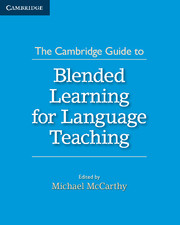Section 4 - Case Studies
Published online by Cambridge University Press: 22 September 2021
Summary
Chapter 10, by Seedhouse, Preston and Olivier, transports us very firmly outside of the conventional classroom and into a digital world where the familiar worktops, tools and appliances of the modern kitchen are implanted with computer technology, making it possible to replicate the real world of getting your fingers dirty with the cooking. It is a prime example of ‘language-in-action’. In this case, what is ‘blended’ is the instructional methods and the computer as mediator. The blend brings together ideas from language pedagogy (task-based learning), technology (the computer interface), communicative skills (reading and speaking) and real-world outcomes (preparing food). The technology and the pedagogy constrain and enhance one another, and there is a built-in element of adaptive feedback, i.e., feedback from the machine tailored to the behaviour of the user at any given moment. The digital kitchen provides a unique opportunity for flipping a typical classroom-based, or at least classroom-generated and controlled, context, to an environment where the learners act autonomously. The chapter shows the potential of technology for creating innovative learning environments and suggests that BL can embrace a range of computer-assisted experiences reassuringly commonplace and akin to the real thing. Central to the authors’ conception of how such a techno-methodological blend should operate are the same issues as would be involved in classroom task-based learning: what competences and skills relevant to language acquisition do the tasks set out to foster, and what types of learning result? The project offers linguistic pay-offs as well as skill gains in terms of noticing key language (as discussed by McCarthy in Chapter 1 of this book), the opportunity to use known language in a real context and expanding the language and interactive repertoire. The project is offered as an example of collaboration between teachers and technology experts, blending the best of both worlds.
In Chapter 11, Moloney and O’Keeffe take us through a blended course for trainee language teachers in a College of Education in Ireland, showing how the selective use of computer-mediated resources can ease some of the stresses of conventional learning in higher education settings, and provide trainee teachers with the necessary first-hand experience of learning in a blended context, as well as looking at learning management systems as an addition to, and a transformative element for, the conventional classroom.
Information
- Type
- Chapter
- Information
- The Cambridge Guide to Blended Learning for Language Teaching , pp. 161 - 162Publisher: Cambridge University PressPrint publication year: 2015
